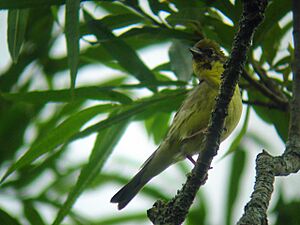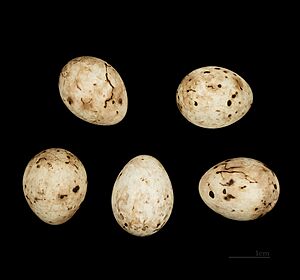Yellow bunting facts for kids
The name "yellow bunting" can also refer to the yellowhammer (Emberiza citrinella).
Quick facts for kids Yellow bunting |
|
|---|---|
 |
|
| Conservation status | |
| Scientific classification |
The yellow bunting is a small bird that lives in eastern Asia. It is also known as the Japanese yellow bunting. Its scientific name is Emberiza sulphurata. This bird belongs to the bunting family, which are small passerine birds.
Sadly, the yellow bunting is facing threats. These include losing its natural home, the use of special chemicals called pesticides, and being caught for the pet bird trade.
Contents
What Does the Yellow Bunting Look Like?
The yellow bunting is about 14 cm (5.5 inches) long. It has a grey bill shaped like a cone. Its feet are a pinkish-brown color, and its eyes are brown.
Male yellow buntings have a grey-green back with black stripes. Their undersides are yellow-green, brightest on the throat and belly. They also have streaks on their sides. Males have black areas around their eyes (lores) and a thin black chin. They have a pale ring around their eyes and white feathers on the outer part of their tail. Their wings have two bars, which are pale tips on some feathers.
Female yellow buntings look similar to males. However, they are usually paler. They do not have the black markings on their lores or chin.
Yellow buntings make a soft, twittering song. They also have a gentle tsip call.
Yellow Bunting Life Cycle
Yellow buntings breed during the warmer months. Their breeding season runs from mid-May to early July.
The female bird builds her nest low down in a bush. Inside the nest, she lays three to five eggs.
Where Do Yellow Buntings Live?
The yellow bunting breeds only in Japan. It is not a very common bird there. Most of them are found on Japan's largest island, Honshu. They might also breed on Kyushu and possibly used to breed on Hokkaido.
These birds live in forests and woodlands. They prefer areas between 600 and 1500 meters (about 2,000 to 5,000 feet) above sea level. This is mainly in the central and northern parts of Honshū.
When winter comes, a few yellow buntings stay in the warmer parts of Japan. However, most of them fly further south. They have been seen in places like the Philippines, Taiwan, Hong Kong, and southeast China during winter. They are rare in all these places. In winter, they can be found in woodlands, bushy areas, grasslands, and even farmlands. Small groups of yellow buntings also pass through Korea when they migrate in spring and autumn.
Protecting the Yellow Bunting
The total number of yellow buntings is small. Sadly, their population is getting smaller. The IUCN (International Union for Conservation of Nature) has classified this species as "least concern." This means they are not in immediate danger of extinction, but their numbers are still low. Experts believe there are only about 2,500 to 9,999 adult yellow buntings left. Their population continues to decrease.
The main threats to the yellow bunting are:
- Habitat loss: Their natural homes are being destroyed or changed.
- Pesticides: These are chemicals used to kill pests, but they can also harm birds.
- Trapping: Some birds are caught and sold for the pet bird industry.



